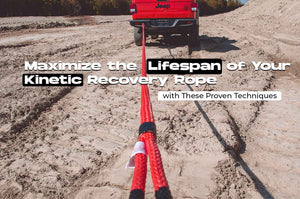Maximize the Lifespan of Your Kinetic Recovery Rope with These Proven Techniques
Mar 28, 2023
Introduction
A kinetic recovery rope is an essential tool for any outdoor or off-road enthusiast. It can help you recover your vehicle from tough terrain, mud, or sand. However, without proper maintenance and care, your recovery rope may not last as long as you want it to. In this blog post, we will discuss techniques and protective measures that can help prolong the lifespan of your kinetic recovery rope.
Importance of Maintaining Your Kinetic Recovery Rope
Your recovery rope is an investment that can save you a lot of money in towing fees or vehicle repairs. To ensure that your rope continues to work effectively and safely, you need to take proper care of it. Neglecting your rope can lead to wear and tear, which can compromise its strength and safety.
Techniques for Prolonging the Lifespan of Your Recovery Rope
Proper storage
When not in use, store your recovery rope in a cool, dry, and shaded area. Avoid exposing it to direct sunlight or extreme temperatures, which can weaken the rope fibers. Also, avoid storing your rope in a tangled or knotted position, as this can damage the fibers.
Cleaning after each use
After using your recovery rope, it is crucial to clean it thoroughly. Rinse the rope with clean water to remove any dirt, sand, or debris. Then, hang it to dry completely before storing it. Avoid using harsh chemicals or solvents, as they can damage the rope fibers.
Avoiding overstretching
When using your recovery rope, avoid overstretching it beyond its recommended limit. Overstretching can cause the rope fibers to break down, reducing the strength and safety of the rope. Check the manufacturer's instructions to determine the recommended stretch limit for your recovery rope.
Inspecting for damage before and after each use
After using the rope, inspect it again for any signs of damage. It's possible that the rope sustained damage during use that may not have been visible before. Check the entire length of the rope for any cuts, frays, or broken fibers. Pay particular attention to the ends of the rope and the areas where knots were tied, as these are common areas for damage to occur.
If you notice any damage, replace the rope immediately. Do not attempt to repair a damaged recovery rope, as this can compromise the strength and safety of the rope.
Regularly inspecting your recovery rope for damage before and after each use can help you catch any potential issues early on, before they become more serious and potentially dangerous. It's better to be safe than sorry when it comes to using recovery equipment, so don't take any chances with a damaged rope.
Protective measures for your recovery rope
a. Use a tree saver strap
When using your recovery rope in a situation where you need to anchor it to a tree, use a tree saver strap to prevent damage to the tree and your rope. A tree saver strap is a protective sleeve that goes around the tree trunk, and your recovery rope attaches to it. This prevents your rope from rubbing against the rough tree bark and causing damage.
b. Avoid dragging your rope on rough surfaces
Dragging your recovery rope on rough surfaces, such as rocks or concrete, can cause significant damage to the rope fibers. This can weaken the rope and reduce its strength and safety. Instead, try to lift the rope off the ground and carry it to the next recovery point.
Conclusion
Your kinetic recovery rope is a valuable tool that can help you out of tough situations. By following the techniques and protective measures outlined in this post, you can prolong the lifespan of your rope and ensure its effectiveness and safety. Proper storage, regular cleaning, avoiding overstretching, inspecting for damage, using a tree saver strap, and avoiding dragging on rough surfaces can all help ensure your recovery rope lasts for years to come. Don't forget to check your manufacturer's instructions for specific care and use guidelines.


